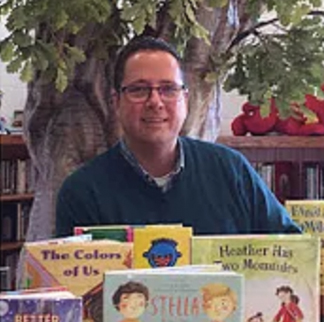What is family?
That is the question, through the lens of kidlit, that I’ve been exploring in my last few blog posts.
In my post, Carefully Taught, I looked at literature that celebrates the variety of ways that a family might look, especially highlighting some titles with same gender parents.
In We Are Family (part one), I took a closer look at children who have to navigate two “families”.
It’s obvious that there are as many “family structures” as there are “families”.
Often you see these labeled as traditional/nontraditional families. I have to admit that this terminology bothers me. Marking something as “traditional” automatically (whether intentional or not) denotes a sense of “rightness”, a hierarchy that implies that one is better, more correct, than another.
The fact is…Families are families! It is important for all children to see their families represented in their classrooms and libraries.
I’m so fortunate to be connected with educators all over the country who are experts in helping kids see themselves in the books they are reading. I asked a couple of them to share book titles that celebrate various family structures.
The first recommendation comes from Kristen Picone. Kristen is a fifth grade teacher in Kings Park, New York. (You can follow her on Twitter: @Kpteach5)
Still a Family
by Brenda Reeves Sturgis

Kristen says…
This is a picture book about a little girl and her parents, who are living in a homeless shelter. Because the shelters are separated by gender, the girl and her mother live separate from her father. Throughout the book, the girl shows us all the ways they are “still a family” despite their circumstances.
Picture books should be used in classrooms with students of all ages. This book can be adapted for students of all ages and may provide a window or mirror for students. We teach students who may have lived in a shelter, possibly separated from their families, as the girl in this book does. We also teach students who will never live under such circumstances, but a book like this one will help to build empathy and possibly lead to action, as students may be inclined to volunteer or donate to shelters in their area. In my classroom, my students were tuned into the repetition of the line “still a family” and powerful discussions ensued about the author’s intention and what it truly means to be a family.
Julie Kirchner, an elementary teacher-librarian from Plymouth, Minnesota shares the next book recommendation. (You can follow her on Twitter: @KitchnerJulie)
Just Like Jackie
by Lindsey Stoddard

Julie says…
Robinson is being raised by her grandfather. He has taught her everything important in life: all about cars, how to make macaroni and cheese, tapping trees to make maple syrup. Lately she notices Grandpa is struggling with his words and remembering, and Robbie is worried. When she can’t stay out of trouble, the stress makes Grandpa’s forgetfulness even worse. Robbie sets out to make sure she stays out of trouble no matter what the bully Alex says or does. When she has to do a family tree project, and has no idea who to add (since she only knows anything about her grandpa) she finds herself getting to the boiling point. Between that stress and trying to keep the secret of her grandpa’s memory loss from the adults in her life, she may boil over. A true heartprint book that reminds us that family has many definitions.
The family piece of this book really hit me as I read it because it explored a family unit, grandparent and grandchild, that is often hard to find (or at least is not equally represented) in children’s literature. Robbie is biracial, her grandfather is black, which might cause people to wonder if she is adopted or his blood relation, and I felt this was another important dynamic to this book. We might make assumptions when we don’t look like our family. There is also a same gender couple, waiting for the birth of their adoptive child in the story. This added another important layer to the story. While not officially related to Robbie and Grandpa, they certainly are an important part of their family.
I couldn’t help thinking how challenging it can be for many students. We have students who are being raised by grandparents or aunts and uncles in our school and I have heard them trying to explain “family” to their peers when the topic of “parents” arises, as it often does. How do we make sure all our students know family can, and often does, mean something other than a mother, father and children.
After reading this book I wondered how many times students are still asked to do family tree projects. I loved how, with time, Robbie was able to see that family doesn’t have to be only those people that are blood related and live with you. It can also be people we love and love us in return.
It is so incredibly important as educators that we validate all families by ensuring that students see their families in the books they are reading. It is equally as important that students see a wide variety of families that are different than their family. Exposure and understanding is the first step to creating a kinder, more empathetic society.
Families are families. Let’s make sure that we are celebrating all of them!

